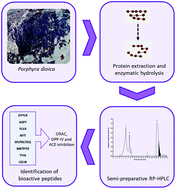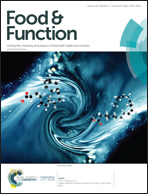Peptide identification from a Porphyra dioica protein hydrolysate with antioxidant, angiotensin converting enzyme and dipeptidyl peptidase IV inhibitory activities
Abstract
A Porphyra dioica protein extract was enzymatically hydrolysed and then fractionated using semi-preparative reverse-phase high performance chromatography. The hydrolysate and its fractions were tested for their oxygen radical absorbance capacity (ORAC) along with their angiotensin converting enzyme (ACE) and dipeptidyl peptidase IV (DPP-IV) inhibitory activities. The most potent fraction was analysed by liquid chromatography mass spectrometry. Eight peptide sequences were selected for synthesis based on their structure–activity criteria for bioactivity. Asp-Tyr-Tyr-Lys-Arg showed the highest ORAC activity (4.27 ± 0.15 μmol Trolox equivalent per μM). Thr-Tyr-Ile-Ala had the highest ACE inhibitory activity (IC50: 89.7 ± 7.10 μM). Tyr-Leu-Val-Ala was the only peptide showing DPP-IV inhibitory activity (IC50: 439 ± 44 μM). Apart from Asp-Tyr-Tyr-Lys-Arg and Thr-Tyr-Ile-Ala, which displayed increased ORAC activity, the bioactivities of the peptides were either maintained or decreased following in vitro simulated gastrointestinal digestion. The results indicate that P. dioica-derived peptides may have potential applications as health enhancing ingredients.



 Please wait while we load your content...
Please wait while we load your content...